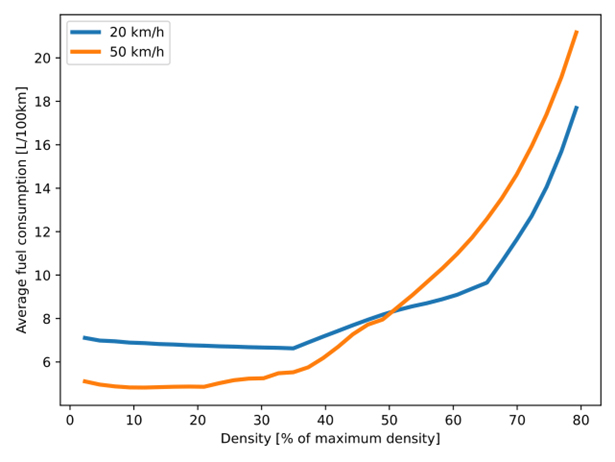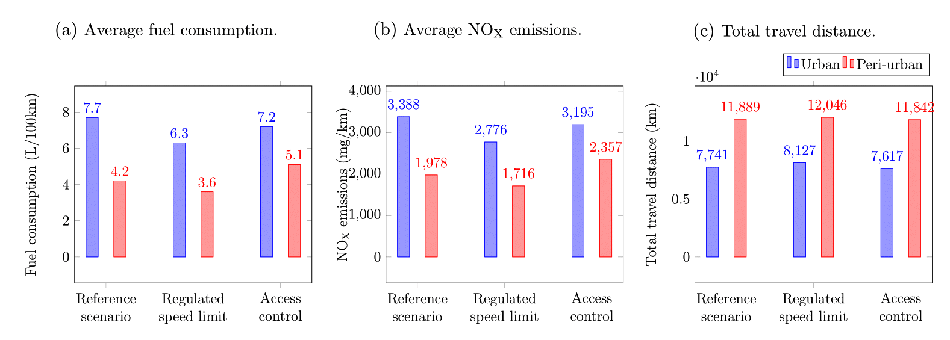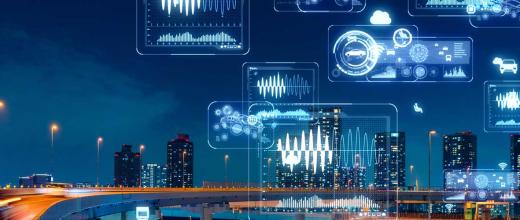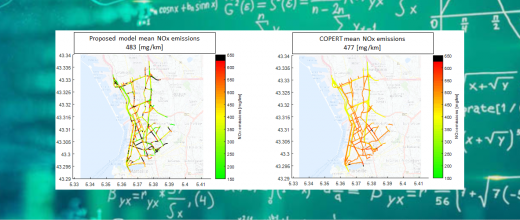Driven by environmental and energy frugality challenges, there is growing interest in vehicle fuel efficiency and a reduction in the impact of mobility. While the promotion of alternative transport modes to cars remains the principal lever for change, much can still be done in terms of road traffic management.
An IFPEN team worked on this subject as part of a thesis in collaboration with Gipsa-lab1 , and developed a dynamic tool for regulating speed limits zone by zone.
A first step in the study consisted in establishing, for different speed limits, the effect of traffic congestion on fuel overconsumption, by coupling:
- an open-access traffic simulator to reproduce vehicle dynamics at various levels of congestion;
- and a model developed by IFPEN to characterize the operation of an engine and estimate the consumption and pollutant emissions of a vehicle, with a high level of precision, depending on a variety of factors: powertrain technologies, the road conditions, driving style and network configuration, etc. [1, 2].
Figure 1 shows the average fuel consumption of vehicles at steady speeds for various traffic densities, for speed limits of 20 km/h and 50 km/h. It is obtained by simulating road traffic at steady speeds (case of a ringroad).
Where traffic density is low, a speed limit of 50 km/h is more energy efficient due to the more favorable engine speed, as long as traffic remains free-flowing. Conversely, above a certain density, a speed limit of 20 km/h becomes less energy-consuming. That is because the “accordion effect” kicks in later, and the associated accelerations, which are largely to blame for overconsumption, are more moderate..

for two speed limits.
Following these observations, the idea for a regulator emerged, in order to adjust the speed limits of an urban zone in real time [3, 4] and thus reduce overall traffic fuel consumption.
The impact of this regulation was evaluated via numerical simulation on a road network covering a distance of around 28 km, comprising an urban area and a suburban area, at rush hour. Its effect was compared to that of two other scenarios:
- a reference scenario: with constant speed limit zones;
- and a scenario known as "access control": with regulated green light timeframes.
The study shows that regulating speed limits makes it possible to:
- reduce fuel consumption (figure 2.a);
- reduce pollutant emissions (figure 2.b);
- improve traffic flow, increasing the distance covered (figure 2.c).

In practice, the regulator slightly lowers the speed limits of road sections leading to zones that are about to become congested. This preemptive action makes it possible to reduce congestion as well as the resulting overconsumption and excessive emissions. It should also be noted that traffic flow is improved as a result.
Furthermore, it turns out that this method is more advantageous than traffic light control, both in terms of fuel efficiency and traffic flow, due to more moderate acceleration and less frequent stops [5].
To realize its full potential, speed limit regulation will need to be evaluated on more complex urban road networks and potentially combined with practices such as eco-driving.
1- Grenoble Images Parole Signal Automatique.
2- SUMO (Simulation of Urban Mobility) software.
References:
- L. Thibault, P. Degeilh, O. Lepreux, L. Voise, G. Alix, G. Corde, A new GPS-based method to estimate real driving emissions, IEEE International Conference on Intelligent Transportation Systems (ITSC), 2016.
>> https://doi.org/10.1109/ITSC.2016.7795776
- A. Pirayre, P. Michel, S. Rodriguez, A. Chasse, Driving Behavior Identification and Real-World Fuel Consumption Estimation With Crowdsensing Data, IEEE International Conference on Intelligent Transportation Systems (ITSC), 2022.
>> https://doi.org/10.1109/TITS.2022.3169534
- B. Othman, G. De Nunzio, D. Di Domenico, C. Canudas-de-Wit, Analysis of the Impact of Variable Speed Limits on Environmental Sustainability and Traffic Performance in Urban Networks, IEEE Transactions on Intelligent Transportation Systems, 2022.
>> https://doi.org/10.1109/TITS.2022.3192129
- B. Othman, Limitations de vitesse variables et contrôle d'accès dans un réseau routier urbain pour une meilleure durabilité environnementale, PhD thesis, 2021.
>> https://www.theses.fr/2021GRALT065
- B. Othman, G. De Nunzio, D. Di Domenico, C. Canudas-de-Wit, Urban Road Traffic Fuel Consumption Optimization via Variable Speed Limits or Signalized Access Control: A Comparative Study, IEEE Conference on Decision and Control (CDC), 2021.
>> https://doi.org/10.1109/CDC45484.2021.9683194
Scientific Contacts: bassel.othman@ifpen.fr ; Giovanni De Nunzio







